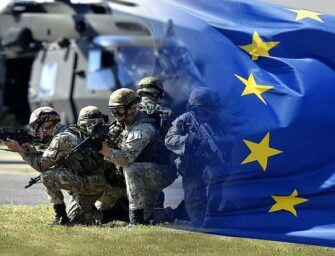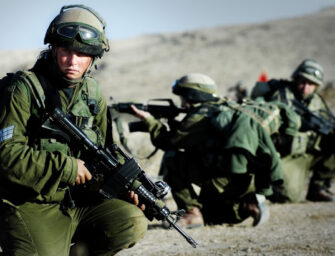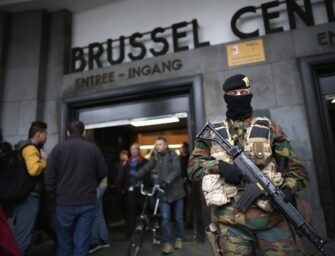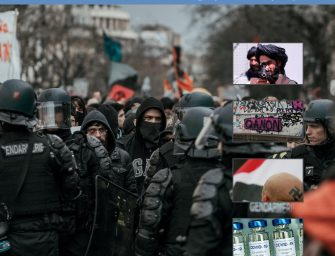Jihadist Terrorism in Europe and Mediterranean Dynamics: Historical, Social, and Operational Evolution in an Era of Global Changes
by Claudio Bertolotti, Director, START InSight, ReaCT
Download here #ReaCT2024 The annual Report on Terrorism and Radicalisation in Europe
Abstract
This article investigates terrorism beyond its traditional definitions; it examines its evolution within the geographical borders of Europe, it emphasizes its historical roots, individual and collective motivations, and operational adaptation, sharing the reasons why a revision of the very definition of terrorism is now necessary, and why it ought to be understood as an effect of violence, rather than an act which is merely organized for political ends. Analyzing the data provided by START InSight’s database, the article focuses on EU countries which are constantly affected by the trajectories of jihadism and the consequent challenges for collective security, while contributing to the academic debate with a multidimensional perspective on terrorism which considers its historical, socio-political and cultural aspects.
Keywords
Jihadism, Functional blockade, Terrorism

1. Terrorism as a political and social phenomenon which evolves over time in response to the changing dynamics of competition between individuals, groups, and states.
Contemporary terrorism, deeply rooted in a complex historical evolution, represents a widespread ideological threat. The threat of jihadist terrorism is particularly significant today and is linked to the historical, conflictual dynamics of international relations and competition in the Middle East and Africa, and to the violence stemming from a radical interpretation of Islam. This conflictual dynamic is increasingly associated with groups’ and individuals’ search for identity through the cultural opposition of a significant segment of second and third-generation immi-grants from the Maghreb living in Europe. We are discussing a fragmented jihadist galaxy characterized by various ideologies and practical approaches, prompting a reconsideration of the concept of contemporary terrorism, which emerges as a social phenomenon distinct from previous forms of terrorism.
This necessary reflection invites us to consider a paradigm shift in the very definition of terrorism, no longer to be understood as an action aimed at achieving political results through violence, hence in its intentions. Instead, terrorism should be seen as the effect of applied violence: it is terrorism, insofar it is a manifestation of violence, without an organization behind it. It is terrorism due to the manifestation, not organization.
Within the same jihadist galaxy, terrorism imposes itself as an instrument of struggle, resistance, and domination, employing various degrees and models of violence: from individual acts to organized, inspired, and insurgent terrorism, of the kind we became acquainted with in Afghanistan and Iraq, and that we now observe in its early manifestations in the Gaza Strip, where the Israel Defense Forces are engaging Hamas (Bertolotti, 2024).
The Afghan experience, which the author of this article has thoroughly studied for many years, combined with the wave of violence following Hamas’s call for strikes against Israel and its allies, has played a decisive role in the resurgence of inspired and emulative terrorism globally. The latter, on the one hand, is based on the victorious experience of the Taliban against the West; on the other, on the anger channeled through Hamas’s communication strategy, which finds resonance in some ideologized Western minorities, conflating Hamas’s violent and terrorist agenda with the legitimate Palestinian cause. Events in international relations are exploited by jihadist rhetoric to demonstrate the righteousness and validity of jihad, and thus of terrorism as a tool of struggle, victory, and justice.
Today, after and alongside Afghanistan, Iraq, and the Gaza Strip, the it’s conflict dynamics in the Middle East and Hamas’s media-amplified terrorism that play this role of ideological and mass involvement drive. This results in emulative forms of violence, which terrorism against Israel has partly provoked and could increasingly provoke in Europe, as well as in North African countries, sub-Saharan Africa, and the Sahel.
2. Trends and Dynamics: Numbers Decline, but the Threat of Terrorism Persists – An Analysis of Attacks from 2014 to 2023
Looking at the past five years, the incidence of jihadist terrorist attacks shows a linear trend from a quantitative perspective, with a noticeable decrease in recent years, returning to pre-Isis/Islamic State levels. From 2019 to 2024, 92 attacks (12 in 2023 and 2024 – situation at 20.09.2024), both successful and unsuccessful, were recorded in the European Union, the United Kingdom, and Switzerland: 99 attacks were recorded in the previous period 2014-2018 (12 in 2015).
In the wake of major terrorist events in Europe in the name of the Islamic State group, and subsequently likely related to galvanizing elements following the Taliban takeover in Afghanistan and the call from Hamas, 206 actions in the name of jihad were recorded from 2014 to 2024, of which 70 were explicitly claimed by the Islamic State: 249 terrorists participated (including 7 women, 73 died in action), 446 victims were killed, and 2,558 were injured (START InSight database).
Both in 2023 and 2024, 12 jihadist actions were recorded, a slight decrease compared to the 18 annual attacks recorded in 2022 and 2021, but with a significant increase in “emulative” actions, inspired by other attacks which took place over the previous days, which raised the figure to the high levels of previous years: from 17% of total emulative actions in 2022 to 58% in 2023 (56% in 2021). 2023 also confirmed an established trend in the phenomenon’s evolution, with an almost exclusive predominance of individual, unorganized actions, generally improvised, progressively replacing structured and coordinated actions characterizing the European urban “battlefield” of 2015-2017 (totality of actions in 2023 and 97% of actions recorded the previous year).

Knives and blades
Terrorists are increasingly using knives for a variety of reasons related to practical, ideological, and strategic factors:
- Ease of access: Knives are readily available and do not require advanced technical skills to use. Unlike firearms or explosives, which may require logistics or technical knowledge, knives are common in every household or store.
- Discretion: A knife can be carried easily without raising suspicion, unlike more conspicuous or dangerous weapons. This allows the attacker to approach victims or locations without being noticed immediately.
- Terror effect: Knife attacks, often conducted in public or crowded spaces, have a strong psychological impact on the population. The close and brutal nature of a knife attack amplifies fear among those present and in the media, creating a significant symbolic effect.
- Individual attacks: In recent years, many terrorist organizations have encouraged individual or “lone wolf” attacks. Knife attacks are ideal for this type of action, as they require minimal planning and can be carried out by a single person without the need for a complex organizational network.
- Weapon control: In many countries, firearm laws are very strict, making it difficult to obtain guns or rifles. Knives, on the other hand, are less regulated and can be legally purchased almost anywhere.
- Inspiration model: Successful knife attacks, like those in various European cities in recent years, have inspired other extremists to replicate this type of action, following the narrative that it is an effective and relatively simple means of spreading terror.
In summary, the growing use of knives by terrorists is linked to their accessibility, ease of use, discretion, and effectiveness in creating panic and fear among the population (Molle, 2024).

3. Profiles of “European” Terrorists
Jihadist terrorism is predominantly a male phenomenon: out of 295 attackers, 97% are male (10 women); contrary to 2020, when 3 female attackers participated in terrorist actions, the 2021-2023 triennium saw no direct participation from them. Identified terrorists (men and women) whose demographic data were disclosed have a median age of 26 years: a figure that varies over time (from 24 in 2016 to 30 in 2019), recording an increase in age in the last analyzed period, delivering a figure of 28.5 years in 2023. The study of the profile of 200 individuals about whom there’s sufficient demographic information draws a very interesting picture: 7% of terrorists are under 19 years old (with a reduction in minors over time), 38% are between 19 and 26, 41.5% are between 27 and 35, and 13.5% are over 35and 13.5% are over 35. These data confirm an in-creasing relevance over time, of the 19-35 age group, with a reduction in minors involved in terrorist attacks over the same period.
93% of the individuals who carried out a terrorist attacks, for whom we have complete information, were “immigrants” (first, second, and third generation), both regular and irregular. 45% of the 155 terrorists, out of a total of 237, who were analyzed in START InSight’s database are first-generation regular immigrants; 28% are descendants of immigrants (second or third generation); irregular immigrants are 26%: a figure which has grown over time, from 25% in 2020, to 50% in 2021, to 67% in 2023, indicating a significant change in the nature of terrorists, with an increasing presence of first-generation attackers (overall 71% of total terrorists). Significant is also the figure related to 7% of European-origin citizens converted to Islam (a slight decline compared to the average of previous years). Overall, 73% of terrorists are legally resident in Europe, while the role of irregular immigrants emerges with a ratio of about 1 in 4 terrorists (the ratio was 1:6 until 2020). In 4% of events, there were children/minors (7) among the attackers, a figure which has decreased.
Ethno-national Dimension of Terrorists in Europe
The phenomenon of jihadist radicalization in Europe affects some specific national and ethnic groups more significantly than others. There is a clear proportional relationship between the main groups of immigrants and terrorists, highlighted by the nationality of terrorists or their families of origin, which reflects the size of foreign communities in Europe. In particular, the Maghreb origin prevails: the ethno-national groups mainly affected by jihadist adherence are Moroccan (especially in France, Belgium, Spain, and Italy) and Algerian (in France). The phenomenon of radicalization has been particularly evident in Belgium and France, where large Moroccan and Algerian-origin communities have seen a significant number of young people join jihadist groups. In France, for example, a significant portion of terrorists involved in recent attacks came from families of Algerian and Moroccan origin, reflecting the historical presence and size of these communities in the country (Bertolotti, 2023).
Recidivists and Terrorists Already Known to Intelligence
The role of recidivists (re-offenders) has grown over time. These are individuals already convicted of terrorism who have committed violent actions at the end of their prison sentence and, in some cases, even within prison facilities. This trend shows a 3% recidivism rate among terrorists who struck in 2018 (1 case), 7% (2) in 2019, 27% (6) in 2020, and 25% (3) in 2023. This situation confirms the social danger of individuals who, although incarcerated, delay the implementation of terrorist actions. This phenomenon suggests an increased likelihood of terrorist attacks in the coming years, parallel to the release of many detainees for terrorism-related offenses.
START InSight highlighted a significant trend regarding terrorist actions carried out by individuals already known to law enforcement or European intelligence. In 2021, such cases represented 44% of the total, while in 2020, they were 54%. This is a significant increase compared to the 10% recorded in 2019 and the 17% of 2018. In 2023 this figure grew to 75%, supporting the concerns of institutions tasked with countering violent phenomena.
Individuals with previous detentions (even for non-terrorism-related offenses) in 2021 confirmed a certain stability in participation in terrorist actions by individuals with a prison record, with a figure of 23% in 2021, slightly down from the previous year (33% in 2020) but in line with 2019 (23% in 2019, 28% in 2018, and 12% in 2017); which seems to confirm that, despite a significantly lower figure in 2023 (8%), prison spaces can be identified as potential radicalization hubs.

4. What is the real destructive capacity of terrorism?
To understand terrorism comprehensively, one must analyze it on three distinct levels: the strategic, the operational and the tactical. Strategy involves the use of resources to achieve long-term war goals. Tactics focus on deploying forces in combat to secure specific victories in battles. The operational level bridges the two, coordinating tactical actions to meet strategic objectives. This synthesis, at its core, highlights the importance of human resources in conducting military actions.
Strategic Success Is Marginal
Strategic success in terrorist actions, defined as achieving significant structural impacts like national and international air/rail traffic disruptions, military mobilizations, or broad legislative interventions, has decreased from 16% to 13%. This is still considered high given the limited organizational and financial efforts by terrorist groups or individuals. Over the years, strategic success rates have shown a declining trend, highlighting a gradual reduction in capacity and effectiveness: 75% in 2014, 42% in 2015, 17% in 2016, 28% in 2017, 4% in 2018, 5% in 2019, 12% in 2020, and 6% in 2021. Since 2022, strategic success has not been achieved by terrorist attacks; effectively confirming an ongoing process of normalizing terrorism.
Media Attention is Decreasing
Media attention towards terrorist attacks is decreasing. Strategically, attacks received international media coverage in 75% of the cases and 95% nationally. Operations by commando and team-raid units received full media coverage. This media success significantly influenced the recruitment campaign of aspiring martyrs or jihadist fighters, peaking during periods of high-intensity terrorist actions (2016-2017). However, the effects of media coverage on recruitment efforts diminishes over time due to two main reasons: firstly, a prevalence of low-intensity actions compared to high-intensity ones, which have decreased, while low and medium-intensity actions have significantly increased from 2017 to 2021, with a notable rise in medium-intensity actions in 2023. Secondly, the public has become gradually less emotionally sensitive to terrorism, particularly low and medium-intensity events.
Despite concerns, Tactical Level Concerns but Is Not a Priority for Terrorism
Assuming the goal of actions is to cause the enemy’s death (with security forces as targets in 35% of cases), this was achieved on average in 50% of the cases between 2004 and 2023. However, the long timeframe significantly impacts the margin of error. An analysis of the 2014-2023 period, shows a worsening trend in the terrorists’ desired effects, with a prevalence of low-intensity attacks and an increase in failed actions, at least until 2022, when tactical success stabilized at 33%, which is consistent with 2016 data. 2023 is an outlier.
Data from the last six years show that in 2016, tactical success was achieved in 31% of cases, with 6% failed acts. In 2017, success rose to 40%, with a 20% failure rate. In 2018, success dropped to 33%, while failed attacks doubled to 42%. In 2019, success further fell to 25%, then rose to 33% in 2020-2022. This trend, interpreted as a dual effect of reduced terrorist operational capacity and increased European security responsiveness, shows a 2023 rate of 50% actions achieving tactical success, i.e., causing at least one fatality.
Operational Success: The “Functional Blockade”
Even when a terrorist attack fails, it produces significant results: it heavily engages armed forces and police, distracting them from routine activities or preventing them from intervening for public welfare. It can also disrupt or overload healthcare services, limit, slow down, divert, or stop urban, air, and naval mobility, and hinder the regular conduct of daily, commercial, and professional activities, harming affected communities. This effectively reduces technological advantages, operational potential, and resilience capacity. Overall, it inflicts direct and indirect damage, regardless of causing fatalities. Limiting citizens’ freedom is a measurable result of these actions. Essentially, terrorism’s success, even without causing fatalities, lies in imposing economic and social costs on society and influencing behaviours over time in terms of security measures or restrictions imposed by political and public safety authorities. This phenomenon is known as a “functional blockade.” Despite the increasingly reduced operational capacity of terrorism, the “functional blockade” remains one of the most important results achieved by terrorists, regardless of tacti-cal success (killing at least one target). From 2004 to the present, terrorism has proven effective in achieving the a “functional blockade” in 80% of cases, peaking at 92% in 2020 and 89% in 2021. This impressive result, obtained with limited resources, confirms the advantageous cost-benefit ratio in favour of terrorism, despite a progressive loss of capacity that saw the “functional blockade” drop to 78% in 2022 and 67% in 2023.
5. Recruitment Capacity and Operational Strategies
The Islamic State, having lost its territory in Syria and Iraq (2013-2017), can no longer send its terrorists to Europe due to the loss of direct external operational projection capacity. However, the group has not lost its power of attraction, which demonstrates its ability to develop indirect recruitment, based on the “posthumous” recognition of individuals who successfully carry out individual terrorist actions. For these reasons, the threat remains significant, thanks to the presence and actions of lone actors, often improvised and driven by emulation, without direct links to the organization.
While the Islamic State continues to impose itself ideologically as the main jihadist threat, particularly exploiting the territorial control and financial resources of its Afghan franchise, the Islamic State Khorasan, it is evident that it cannot replicate the overwhelming appeal of the “caliphate” in 2014-2017. The novelty advantage and consequent appeal, particularly towards the youth, have diminished. Additionally, the European Union has significantly reduced its vulnerabilities legislatively and operationally, with more emphasis on counterterrorism than preventive action.
Concerns persist regarding emulative effects and the “call to arms” related to international events that can induce individuals to act in the name of jihad. The most significant event in 2021, which continues to fuel transnational jihad, was the Taliban’s victory in Afghanistan. This victory fed diverse jihadist propaganda with the message that “victory is the result of continuous struggle” and created competition among jihadi groups engaged in exclusively local struggles and those like the Islamic State, which promote jihad as a relentless global struggle. This competitive dynamic includes actions associated with the Israel-Hamas war and the jihadist call to violence, where Islamic State followers and Hamas supporters have vied for battlefield successes and consequent media attention.
In this continually evolving scenario, attention must be paid to jihadist strength in the African continent, particularly in sub-Saharan Africa, the Sahel, the Horn of Africa, Rwanda, and Mozambique, in order to counter the emergence of new “caliphates” or “wilayats” that could directly threaten Europe. In prolific jihadist propaganda, the Islamic State boasts of its spread in Africa, in a competitive / collaborative relationship with its Afghan franchise. It highlights how the aim of combating the presence and spread of Christianity will lead to the group’s expansion in other areas of the continent. In places like the Ma-ghreb, the Mashreq, and Afghanistan, the Islamic State’s activity focuses on intra-Muslim sectarian struggle. In Africa, its presence has become part of a Muslim-Christian conflict, strengthened by propaganda centred on stopping Muslims from converting to Christianity through the work of “missionaries” and the pretext of humanitarian aid. Violence, kidnappings, and the kill-ing of missionary clergy, attacks on NGOs and international missions from Burkina Faso to the Congo, as well as attacks on Christian communities, are all part and parcel of this context.
From North Africa to the Sahel: A Look at “Mediterranean” Terrorism
Looking at North Africa, the region continues to face threats from groups affiliated with al-Qaeda in the Islamic Maghreb (AQIM), the Islamic State, and foreign terrorist fighters (FTFs) who have travelled to Iraq or Syria. The unnoticed return of these fighters to their home countries following the Islamic State’s territorial defeat poses additional security challenges. In recent years, lone actors and small cells have carried out a series of deadly attacks in various North African states, proving difficult to detect. The Sahel is becoming a new center of jihadist terrorism, with a significant increase in victims in 2023. However, the MENA region (Middle East and North Africa) has seen a 42% decrease in victims over the past three years. North Africa, in particular, is witnessing a steady reduction in extremist violence, with the number of violent attacks returning to pre-IS levels. In 2022, North Africa saw a 14-fold decrease in victims com-pared to 2015, with Morocco being the safest country in the region, while Egypt remains one of the most affected by terrorism. Libya, Algeria, and Tunisia fall between these extremes with medium to low terrorism impact.
The Sahel and the Maghreb are politically, economically, and security-wise connected. The presence of terrorist groups exploiting ethnic tensions, climate challenges, and lack of public services has turned this region into a hub of jihadist activity, with the risk of spreading the terrorist threat to other areas.
Instability in the Sahel has already affected West Africa and the coastal countries of the Gulf of Guinea, where al-Qaeda-affiliated groups are active. This situation could also involve North Africa, jeopardizing the progress made in prevention, counterterrorism, and deradicalization in some countries of the region.
Considering that North African countries are both emigration and transit countries for migratory flows to Europe, this raises the question of possible jihadist contamination or transfer. Monitoring the evolution of a phenomenon in the process of consolidation, which finds its lifeblood in the Mediterranean area, is therefore paramount.
Claudio Bertolotti, ISPI, START InSight’s Director and Director of the Observatory on Radicalization and Counter-Terrorism (ReaCT). Claudio Bertolotti holds a Ph.D. and serves as the Executive Director of START InSight. From 2014 to 2023, he was a senior researcher with the “5+5 Defense Initiative.” He graduated in Contemporary History, specialized in Sociology of Islam, and earned a doctorate in Sociology and Political Science, focusing on International Relations. His work focuses on crisis areas, national strategic interests, national security, the Mediterranean, intercultural dialogue, and, in particular, Islamic radicalism, terrorism, jihadism, and migration flows. Since April 17, 2019, he has been the Executive Director of ReaCT – National Observatory on Radicalism and Counter-Terrorism (Rome-Milan-Lugano). Since September 30, 2021, he has been a member of the Committee on Human and Civil Rights at the Regional Council of Piedmont. He is the author of several works, including Gaza Underground: The Underground and Urban Warfare between Israel and Hamas. History, Strategies, Tactics, Cognitive Warfare, and Artificial Intelligence (START InSight, 2024), Immigration and Terrorism (START InSight, 2020), Contemporary Afghanistan. Inside the Longest War (CASD, 2019), and Shahid: Analysis of Suicide Terrorism in Afghanistan (FrancoAngeli, 2010). Corresponding with the Author: claudio.bertolotti@startinsight.eu.
Bibliography
Bertolotti, C. (2024), Gaza Underground: la guerra sotterranea e urbana tra Israele e Hamas. Storia, strategie, tattiche, guerra cognitiva e intelligenza artificiale, START InSight ed., Lugano.
Bertolotti, C. (2023), Unraveling the Evolution of Terrorism in Europe: Left-Wing, Far-Right, Anarchist, and Individual Terrorism, and the Role of Immigrants in Jihadist Terrorism within the European Union (Correlation and Regression Analysis), pp. 77-87, in #ReaCT2023, 4th Report on Counter-Terrorism and Radicalization in Europe, START InSight ed., Lugano, ISBN 978-88-322-94-18-7, ISSN 2813-1037 (print), ISSN 2813-1045 (online)













































There are no comments
Add yours